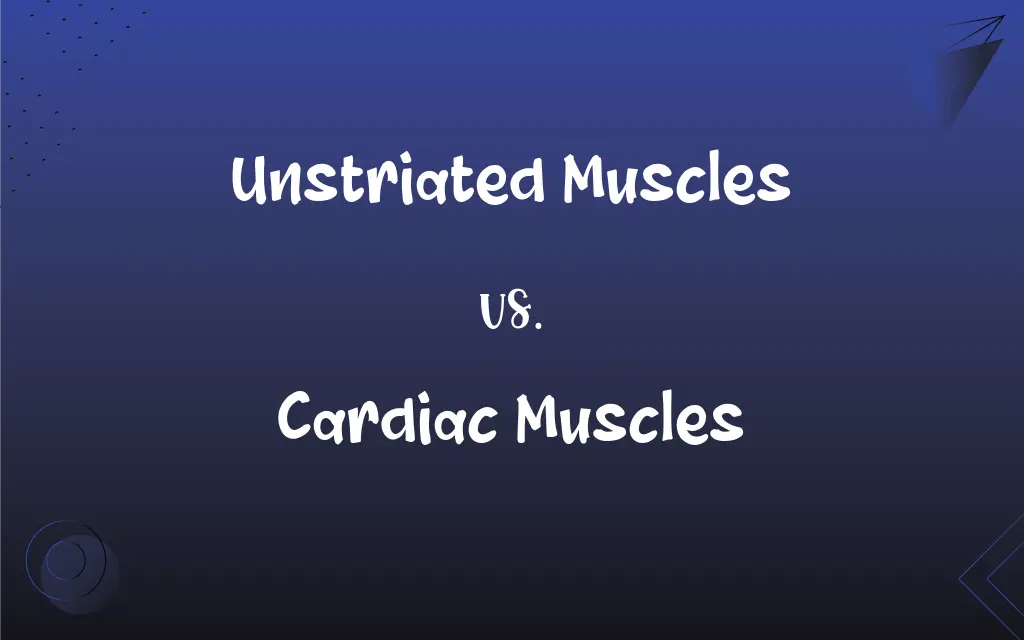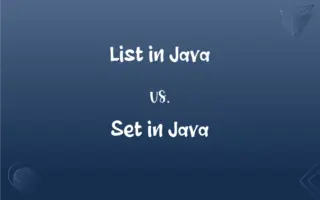Unstriated Muscles vs. Cardiac Muscles: What's the Difference?
Edited by Aimie Carlson || By Harlon Moss || Published on February 26, 2024
Unstriated muscles, also known as smooth muscles, are involuntary, non-striated muscles found in organs, while cardiac muscles are striated, involuntary muscles found exclusively in the heart.

Key Differences
Unstriated muscles are found in various internal organs and are responsible for involuntary movements like digestion and blood vessel constriction. Cardiac muscles, in contrast, are found only in the heart and are specialized for continuous, rhythmic contractions.
Unstriated muscles operate without conscious control, performing functions such as regulating the diameter of blood vessels. Cardiac muscles also function involuntarily but are unique in their automaticity, initiating their own contractions to pump blood.
The cells of unstriated muscles are spindle-shaped and do not have visible striations (stripes) under a microscope. Cardiac muscle cells, however, are branched and interconnected with visible striations, due to the alignment of contractile proteins.
In terms of regeneration, unstriated muscles have a limited ability to repair and regenerate, useful in organ repair. Cardiac muscles have very limited regenerative capacity, which is a challenge in heart disease treatment.
Unstriated muscles are controlled by the autonomic nervous system, responding to various stimuli like hormones. Cardiac muscles are influenced by the autonomic nervous system but primarily governed by intrinsic pacemaker cells.
ADVERTISEMENT
Comparison Chart
Location
Throughout the body in organs
Exclusively in the heart
Control
Involuntary, autonomic nervous system
Involuntary, intrinsic pacemaker cells
Cell Shape
Spindle-shaped, no visible striations
Branched, striated
Function
Regulate organ functions, vessel constriction
Pump blood continuously
Regeneration Capacity
Limited ability to repair and regenerate
Very limited regenerative capacity
ADVERTISEMENT
Unstriated Muscles and Cardiac Muscles Definitions
Unstriated Muscles
Play a role in involuntary body functions.
The unstriated muscles of the intestine help in the digestion process.
Cardiac Muscles
Have branching cells interconnected by intercalated discs.
Cardiac muscles' interconnected nature facilitates coordinated heart contractions.
Unstriated Muscles
Involuntary muscles found in the walls of internal organs.
The unstriated muscles in the digestive tract aid in moving food along.
Cardiac Muscles
Involuntary muscles with an intrinsic ability to contract.
The consistent beating of the heart is due to the automaticity of cardiac muscles.
Unstriated Muscles
Have a limited ability to regenerate.
The unstriated muscles in damaged organs can undergo limited repair.
Cardiac Muscles
Possess limited regenerative capacity.
The healing process in cardiac muscles after a heart attack is often challenging.
Unstriated Muscles
Non-striated, smooth muscles controlled by the autonomic nervous system.
Blood flow is regulated by the unstriated muscles in the arterial walls.
Cardiac Muscles
Specialized striated muscles found only in the heart.
Cardiac muscles contract rhythmically to pump blood throughout the body.
Unstriated Muscles
Lack visible striations and are spindle-shaped.
Unstriated muscles in the bladder contract to facilitate urination.
Cardiac Muscles
Governed by internal pacemaker cells and the autonomic nervous system.
Heart rate variability is influenced by the autonomic control over cardiac muscles.
FAQs
Can unstriated muscles regenerate?
Unstriated muscles have a limited capacity for regeneration and repair.
What controls unstriated muscles?
Unstriated muscles are controlled by the autonomic nervous system.
What is unique about the structure of cardiac muscle cells?
Cardiac muscle cells are branched and interconnected by intercalated discs, aiding in coordinated contractions.
What are unstriated muscles?
Unstriated muscles are smooth, involuntary muscles found in internal organs.
What are cardiac muscles?
Cardiac muscles are specialized, striated muscles found exclusively in the heart.
Where are unstriated muscles located?
Unstriated muscles are located in various organs like the intestines, blood vessels, and bladder.
What is the primary function of cardiac muscles?
The primary function of cardiac muscles is to contract rhythmically to pump blood.
What are the visible features of unstriated muscles under a microscope?
Unstriated muscles do not have visible striations and appear smooth.
How do unstriated muscles differ from striated muscles?
Unstriated muscles lack visible striations, unlike striated muscles found in skeletal and cardiac muscle.
Can cardiac muscles repair themselves after injury?
Cardiac muscles have very limited regenerative capacity, making heart damage often permanent.
How do cardiac muscles contribute to heart rate regulation?
Cardiac muscles are influenced by the heart's intrinsic pacemaker cells and autonomic nervous system, regulating heart rate.
What is the lifespan of cardiac muscle cells?
Cardiac muscle cells have a long lifespan and do not frequently divide.
Are cardiac muscles voluntary or involuntary?
Cardiac muscles are involuntary and contract automatically.
What role do cardiac muscles play in blood circulation?
Cardiac muscles contract to pump blood through the heart chambers and into the circulatory system.
Are unstriated muscles involved in breathing?
Yes, unstriated muscles in the bronchi and bronchioles play a role in regulating airflow during breathing.
Can unstriated muscles respond to hormonal changes?
Yes, unstriated muscles can respond to hormonal stimuli, affecting their contraction and relaxation.
Do cardiac muscles tire easily?
No, cardiac muscles are highly resistant to fatigue, enabling the heart to beat continuously.
What stimulates the contraction of unstriated muscles?
Unstriated muscles contract in response to signals from the autonomic nervous system and various chemical stimuli.
How do unstriated muscles function in the digestive system?
They facilitate the movement of food through peristalsis in the digestive tract.
Are unstriated muscles affected by exercise?
Indirectly, as exercise can influence the autonomic nervous system which controls unstriated muscles.
About Author
Written by
Harlon MossHarlon is a seasoned quality moderator and accomplished content writer for Difference Wiki. An alumnus of the prestigious University of California, he earned his degree in Computer Science. Leveraging his academic background, Harlon brings a meticulous and informed perspective to his work, ensuring content accuracy and excellence.
Edited by
Aimie CarlsonAimie Carlson, holding a master's degree in English literature, is a fervent English language enthusiast. She lends her writing talents to Difference Wiki, a prominent website that specializes in comparisons, offering readers insightful analyses that both captivate and inform.







































































